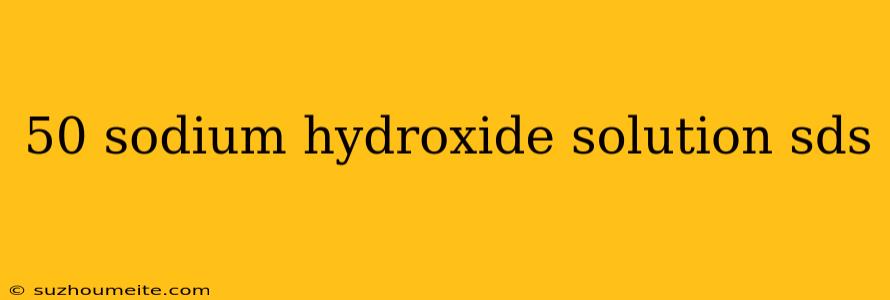50% Sodium Hydroxide Solution SDS
Section 1: Identification
Product Identifier
- Product Name: 50% Sodium Hydroxide Solution
- Synonyms: Caustic Soda, Sodium Hydrate, Lye
Manufacturer Information
- Manufacturer Name: [Insert Manufacturer Name]
- Manufacturer Address: [Insert Manufacturer Address]
- Emergency Phone Number: [Insert Emergency Phone Number]
Section 2: Hazards Identification
Classification
- Classification according to OSHA Hazard Communication Standard (29 CFR 1910.1200): Corrosive, Eye Irritant, Skin Irritant, Respiratory Irritant
- Classification according to EU Regulation (EC) No 1272/2008 (CLP): Corrosive, Skin Corrosion/Irritation, Serious Eye Damage/Irritation, Respiratory Irritation
Hazard Statements
- H314: Causes severe skin burns and eye damage
- H335: May cause respiratory irritation
- H402: Harmful to aquatic life
Precautionary Statements
- P260: Do not breathe mist/vapors
- P264: Wash thoroughly after handling
- P270: Do not eat, drink or smoke when using this product
- P280: Wear protective gloves/protective clothing/eye protection/face protection
- P305+P351+P338: IF IN EYES: Rinse cautiously with water for several minutes. Remove contact lenses, if present and easy to do. Continue rinsing
- P310: Immediately call a POISON CENTER/doctor/…
Section 3: Composition/Information on Ingredients
Ingredient
- Sodium Hydroxide (CAS-No: 1310-73-2)
Concentration
- 50% w/w Sodium Hydroxide
Section 4: First Aid Measures
Skin Contact
- Immediately flush skin with plenty of water for at least 15 minutes
- Remove contaminated clothing and shoes
- Wash skin with soap and water
- Get medical attention immediately
Eye Contact
- Immediately flush eyes with plenty of water for at least 15 minutes
- Remove contact lenses, if present and easy to do
- Continue rinsing
- Get medical attention immediately
Inhalation
- Remove to fresh air
- If breathing is difficult, give oxygen
- Get medical attention immediately
Ingestion
- Never give anything by mouth to an unconscious person
- Get medical attention immediately
Section 5: Firefighting Measures
Extinguishing Media
- Use water spray, dry chemical or foam to extinguish fires
- Do not use water jet
Fire and Explosion Hazards
- Sodium hydroxide solution is not flammable, but it can ignite combustible materials
- The solution can release toxic fumes when heated
Section 6: Accidental Release Measures
Personal Precautions
- Wear protective gloves/protective clothing/eye protection/face protection
- Ensure adequate ventilation
- Evacuate area
Environmental Precautions
- Prevent further leakage or spillage if safe to do so
- Do not let product enter drains
Methods for Containment and Cleaning Up
- Contain spillage with non-combustible materials (e.g. sand, earth)
- Neutralize with acid (e.g. acetic acid, citric acid)
- Absorb with an absorbent material (e.g. vermiculite, activated carbon)
- Dispose of according to local regulations
Section 7: Handling and Storage
Handling
- Handle in a well-ventilated area
- Avoid contact with skin and eyes
- Avoid ingestion
Storage
- Store in a well-ventilated area
- Keep container tightly closed
- Keep away from heat, sparks and open flames
Section 8: Exposure Controls/Personal Protection
Exposure Limits
- OSHA PEL: 2 mg/m³ (as NaOH)
- ACGIH TLV: 2 mg/m³ (as NaOH)
Personal Protective Equipment
- Wear protective gloves/protective clothing/eye protection/face protection
- Respiratory protection: wear a dust mask or self-contained breathing apparatus
Section 9: Physical and Chemical Properties
Physical State
- Liquid
Odor
- Pungent, alkaline odor
pH
- pH 14 (50% solution)
Boiling Point
- 138°C (280°F)
Solubility
- Soluble in water
Section 10: Stability and Reactivity
Stability
- Stable under normal conditions
- Reacts with acids and moisture
Reactivity
- Reacts with acids, forming sodium salts and water
- Reacts with organic matter, forming complex compounds
**Section 11
